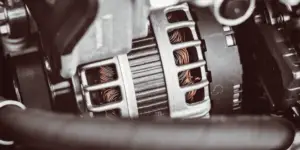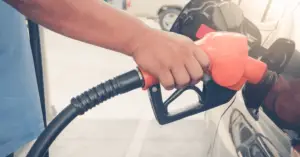If your car dies when driving, it can be really worrying. What if it happens again in fast moving traffic or when you have loved ones with you?
Here we’ll examine each in more detail and explain the fault, cause, and repair costs.
A car dies when you’re driving either because there’s a lack of fuel or air entering the engine, interrupting the combustion. Less common causes are a bad alternator, faulty sensors, or an empty fuel tank.
Let’s explore each of these reasons in more detail.
Car Died While Driving. No Other Symptoms
It seems obvious, so I thought I’d get this reason answered first before we move on.
Fuel gauges can and do break – actually, the sensor within the fuel tank goes bad and can give a wrong reading.
Fix:
Add a little fuel and see if the gauge moves. The sensor is connected to a float in the fuel tank and sends the reading to the fuel gauge. They can stick, become erratic and break completely, giving an incorrect reading.
The fix is to replace the sensor. As it’s located in the tank, you’ll have to drain away any fuel – that’s why it’s best only to top up a small amount to see if the gauge moves – to get to it.
A competent DIY mechanic will be able to do the fix themselves. For most, though, it’ll mean a trip to a mechanic.
The part – depending on the make and model of the car- is between $30 and $80, and the labor costs will be $150 to $220. Therefore expect to pay between $180 and $300 in total.
Car Dies Under Hard Acceleration or On A Steep Hill
Likely causes
- Fuel Pump
- Fuel Injectors
- Fuel Filter
Over time, your fuel filter, pump, or injectors can get clogged by impurities in the fuel. The harder the fuel pump has to work, the more likely it is to be unable to cope.
This makes sense under hard acceleration but also on hills where the pump has to push the fuel to the engine against gravity.
For some older cars, the fuel filter below the tank can rust out, too – rare, though. This rust can mix in with the fuel and damage the injectors in the engine.
Fixes and costs:
Fuel Filter: Filters are cheap to buy but take some effort and time to cleanly remove as some fuel might spill. They’re usually located right at the fuel tank’s exit.
Like other filters, there’s little point in cleaning them out as they are cheap to replace, costing between $20 and $80 for the part. Labor is cheap, too, as they are usually located on the fuel line, leaving the fuel tank en route to the engine.
Fuel pump. Located inside the fuel tank, a healthy fuel pump hums for a few seconds as soon as the key is turned to the “on” position before turning on the engine itself.
If you hear any other noise than a hum, it means that the pump is starting to fail. If you hear nothing, a blown fuse might be the cause. These are easy to check and should always be what you do before considering replacing the pump itself if you hear no pump sound.
A replacement fuel pump part costs anywhere from $80 to $150 plus labor costs of $100 to $220. In total, expect a mechanic to charge you between $180 and $370 in total.
Fuel Injectors:
Fuel injectors can often be cleaned without the need to remove parts. A liquid cleaner added to the fuel will clean a mild to moderate carbon buildup. This is a very cheap solution – if it works.
A bottle costs around $15 and is always worth a try. If it doesn’t clear the carbon, you’ll need to pay a mechanic to manually clean or replace the injectors.
They are located inside the engine so unless you’re competent, leave well alone and take your car to a professional. They’ll try and salvage them for you, but they often need replacing.
Labor costs can be high – they always are when the engine needs to be opened – so expect to pay $300 – $600 in labor. Most cars have only one fuel injector per cylinder, costing around $60. It’s good practice to replace all of them at once, as if one fails, the others won’t be too far behind.
Far better to spend an additional $180 on three more injectors now than have to pay $300 + in labor and injector costs in a few months.
Air Filter Clogged Up.
We’ve concentrated on fuel and electrical causes so far.
However, there may be a cheaper fix. Engines need clean air to burn alongside fuel. Air on its way to the engine – to combust with the fuel – may get blocked by a dirty air filter. A lack of air will result in a lack of combustion and the engine to die.

Fixes: The air filter is located in a square or circular black box in the engine bay. If it’s dirty, you can either try and clean it – shake it and use a brush – or replace it. Air filters are cheap and are normally replaced during a car service and tune-up.
Expect to pay between $15 – $40 depending on the make and model of your car.
Battery or Alternator Going Bad
In modern vehicles, even with the engine running, the battery can be asked to provide power when the alternator is under extreme load. If the battery weakens or dies, that electrical load increases on the engine itself. This causes RPMs to drop.
Pay attention to how the engine reacts to turning on the headlamps and blinkers, infotainment, and everything else at once when the car is idling. If your car nearly stalls at idle, this may be it.
That being said, if you’re driving and your car dies, it’s much more likely to be the alternator than the battery that’s not working correctly. You can drive short distances without an alternator, but the battery will soon die, and you’ll be stranded.
Fixes:
It is essential to check your battery voltage when running and with the engine off. While that’s being done, checking the alternator is also necessary. Many times drivers buy a new battery only to find that it dies too, and it was a bad alternator, to begin with.
Here we discuss why an alternator goes bad and the tests you can do to confirm it.
A new alternator price varies depending on the make and model of the car. They can be repaired if the fault is minor – bearings, for instance- but a new one will be needed if left.
Expect to pay $300 to $600, including parts and labor.
A new battery generally lasts 2-3 years unless you buy a higher-end one, which can stretch to five years.
Bad Sensors:
Software and electrical issues can reset when the car is turned off and restarted.
Modern engines run based on parameters and computer software. With incorrect values or rogue crankshaft position sensors, the engine will either want to shut off to decrease – sometimes perceived – damage or stall due to receiving wrong instructions.

Check for bad sensors using an OBDII reader or compliant car scanner. They plug into the car and read fault codes that you can then look up online to see what is causing the fault.
Car Shuts Down When Slow or Pressing The Clutch?
In older cars, generally, pre-2010, there’s a screw that can be adjusted on the throttle body. It could be that your idle RPM settings have somehow been messed up by this screw being knocked.
It can be quite difficult to notice when your car is cold as cars run faster. When they are up to temperature and slowing down or stationary, it might stall on you.
Many visitors also read this article: Why Does My Car Shake When I Stop? – 11 Fixes with Costs
Fix:
Although not recommended, as discussed, there is a screw near the car’s throttle body that can be turned to increase or decrease the idle RPMs. Newer cars don’t have this.
Car Beeps and Locks and Then Shuts Down During Driving
If you have a newer car, especially one with a push-button to start the car, your key or immobilizer may be faulty. Cars with the security feature may turn off while driving if it does not sense the key inside/near the car.
This is done to prevent easy theft as cars can be unlocked and started with the key only being in range. Later as it realizes there is no key, the car will lock.
In Conclusion
A car shuts off when driving because
- Lack of fuel
- Clogged air filter
- Alternator faulty
- A bad crankshaft position sensor
- Bad fuel pump












